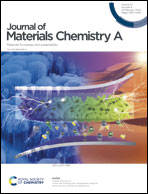Regulating the phase stability and bandgap of quasi-2D Dion–Jacobson CsSnI3 perovskite via intercalating organic cations†
Abstract
Currently, as a promising alternative of lead halide perovskites, nontoxic lead-free CsSnI3 perovskites have drawn increasing attention. However, the development of tin-based perovskites is still greatly hindered by their intrinsic deficiencies, such as their easy phase transformation. To address this issue, we theoretically proposed the design of quasi-2D Dion–Jacobson (DJ) CsSnI3 perovskites intercalated with π-conjugated 2,5-thiophenedimethylammonium (ThDMA) based on first-principles computation. The phase stability of the quasi-2D (ThDMA)Csn−1SnnI3n+1 perovskites could be fundamentally enhanced owing to the strong I–H interaction between the ThDMA2+ cations and [SnI6]4− inorganic layers. The bandgap could be linearly tailored from 2.55 (n = 1) to 1.35 eV (n = ∞) as a result of the engineered anti-bonding states of Sn–I bonding strength with tailored frontier bands by dimensional engineering. These results might give some meaningful insight for exploring environmentally friendly CsSnI3 perovskites with expected applications in opto/electronic devices.



 Please wait while we load your content...
Please wait while we load your content...